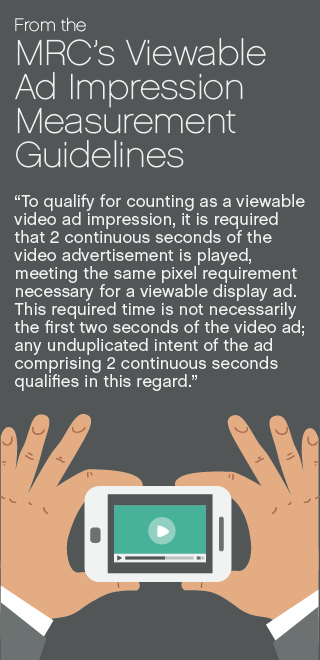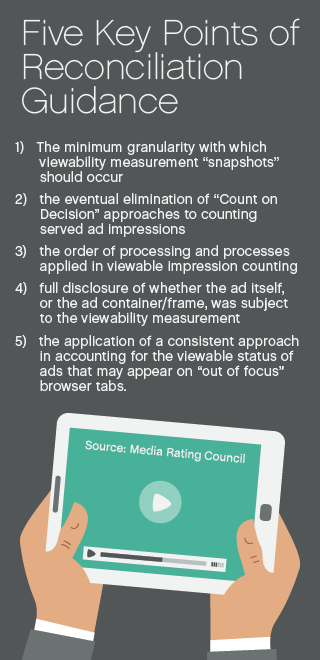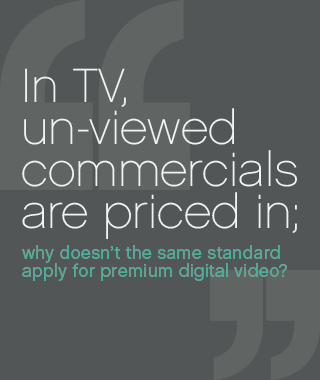
Fifty percent of pixels in view on the in-focus browser tab for two continous seconds. It doesn’t seem like a giant barrier to cross for a video ad to be considered in-view – and that was the point.
Following the June 30 lifting of the Media Rating Council’s advisory against transacting video on a viewable basis, agency folk took to the ad tech trades to grumble about the seemingly low standard. But these agencies were highly involved in the discussions deciding on the threshold – in fact, the main reason video viewability was gated for 90 days longer than display viewability was developmental disagreement over the time aspect. Some publishers still argue that the time element turns viewability from a counting metric to an engagement metric.
So 50% for two seconds was a compromise between the demand and sell sides; more important, it’s a baseline, the bare minimum for the purpose of defining and counting. Two seconds was not an arbitrary number: empirical testing on billions of impressions found an 80%-85% likelihood that if a video was in view for two seconds, the user had watched the entire video.
Sherrill Mane, Senior Vice President, Research, Analytics and Measurement for the IAB, notes that the standard is a minimum for measurement and is a guide for transactions even though the market ultimately determines whether or not the measurement minimum is the transactional standard. David Gunzerath, SVP & Associate Director at the MRC, adds: “We hope players go above and beyond our relatively simple metric; we encourage innovation.”
Agencies and publishers will negotiate their own video viewability addenda based on the offerings of providers being used – campaign terms and conditions will increasingly reflect preferred vendors’ capabilities (and limitations). These can include player muting recognition, invalid traffic monitoring, hover metrics, etc. And publishers reply that this lack of consistency undermines the idea of viewability as a currency and effectively cripples their ability to develop pricing models.

The video viewability space is even less mature than the display viewability market – organizations across the spectrum are earlier in the developmental process, and many publishers believe the technology is half-baked. Plenty are still upset with the approach taken to viewability – multiple measurement methodologies from a variety of companies shoehorning to a heavily debated standard. One publisher comments that the digital medium has never been conducive to universal metrics, thanks to widely varying algorithms housed in black box technology.
Three providers – Telemetry, Moat and Videology – have received video viewability accreditation from the MRC, while Tremor Video has also received accreditation for the Average Viewability Percentage component of its VideoHub platform. Six more providers are currently in the MRC’s pipeline and many others are preparing to be appraised. The lifting of the advisory didn’t open the floodgates, but talk of guaranteeing viewability in video transactions made the rounds during this year’s upfronts.
IAB’s Mane expects to see serious viewable video traffic in the next six months, but there are many issues that leave the scalability of video viewability in doubt, even with such a minimal standard. Some of these problems are familiar to the display space, such as the wide variability between vendor reporting partially driven by divergent measurement methodologies. Some are unique to video, such as the challenge in guaranteeing against demo and viewability. And then there’s the power angle: premium video inventory is in high demand and low supply, giving a great deal of leverage to major video producers like broadcasters.
Although there’s been nonstop contention over viewability for the last few years, most industry players concede video viewability is a worthy cause, one that will ultimately increase transparency in transactions. But is that enough to drive adoption?
An Unfair Burden?
According to a recent IAB report (PDF), 67% of agencies plan to boost their digital video spend, taking some budget from TV; advertisers anticipate spending 17% more on digital video in 2014 than in 2012 (with a high percentage bought through upfronts and newfronts.) It’s been a huge revenue driver for publishers, a cash cow that not surprisingly has attracted unsavory players. There are numerous tactics for committing fraud, some straight out of the display fraud handbook: hidden video players, multiple video players, auto-play below the fold, etc.
Such tricks are mainly found on long-tail and mid-tail sites, particularly at the end of the month or quarter when various parties are trying to meet impression promises. And while not completely complicit, chief accomplices are networks and exchanges. Similar to the display world, agencies seeking cheap (read: underpriced) video inventory are getting what they paid for: lots of unseen video ads.

Outrage went viral when a late 2013 survey by Vindico (PDF) – a demand-side video ad server that claims to serve 40% of all video ads – deemed around 57% of 8 billion video ads served “unviewable.” The definition of viewable in this case was actually lighter than the MRC standard: 50% of pixels in view for one second.
The frustration from premium video publishers, notably broadcasters, runs deep. They feel they’re being punished for the work of supply-side and intermediary bad actors – and the irresponsible buying of agencies. For some, viewability’s added layer of complexity seems like an end-run way to get publishers to drop prices (on their most valuable inventory at that).
A common fear: agencies will demand publishers pay for the viewability component in campaigns, which will slash impressions. Then for the double whammy: the publishers potentially will have to provide a makegood based on the viewability service they were forced to pay for. You can imagine that cutting deep into pub margins.
By the way, viewability is not a cure-all for video fraud – in particular, a bot can hit the play button and will stay on a page until a video is finished. Unless an invalid traffic monitoring or blocking service is in place, that would likely be counted as a viewed video. (Bot-detection technology has also come under a fair deal of scrutiny.)
Some viewability providers also offer invalid traffic monitoring, but that aspect is not and will not become an aspect of the viewability standard, the MRC reports. Invalid traffic standards are another initiative entirely, similar to verification. However, it’s easy to see where vendors offering multiple services – for example, viewability, verification and invalid traffic monitoring – may prosper in a crowded field.
Great Variability
One hundred percent video viewability is not realistic any time soon (or ever, some have argued); currently most publishers and agencies I spoke with were setting benchmarks in the 70% range, which is quite similar to display.
However, premium video publishers have built their sites with viewability top of mind – the players sit in well-lit environments above the fold. They’re quite skeptical of measurement technology they view as immature and put out in a rush to jump on the standard – especially considering the wide variability they are seeing in reporting from provider to provider. One publisher noted a 50-point difference in testing two different providers.
 Part of the challenge here is providers analyzing small sample sizes when traffic can fluctuate greatly from day to day. But the main cause of variability is differences in measurement methods from vendor to vendor. This goes beyond whether measuring the video from the player or enclosure (iframe or SafeFrame). The vendor could be using a geometric method (determining a video ad’s location based on the iframe x/y coordinates on a page), location pixels attached to a unit, or JavaScript signals from the browser. Some providers offer combinations of these methods or all of the above.
Part of the challenge here is providers analyzing small sample sizes when traffic can fluctuate greatly from day to day. But the main cause of variability is differences in measurement methods from vendor to vendor. This goes beyond whether measuring the video from the player or enclosure (iframe or SafeFrame). The vendor could be using a geometric method (determining a video ad’s location based on the iframe x/y coordinates on a page), location pixels attached to a unit, or JavaScript signals from the browser. Some providers offer combinations of these methods or all of the above.
But viewability measurement can also run afoul thanks to issues with the latest version of the VPAID XML schema, which allows ad units to communicate with video players and can be used by advertisers to collect interactivity metrics. A method built into the VPAID application appears to be the “cleanest” (i.e., most transparent) method for measuring video viewability, though publishers do warn of latency issues when VPAIDs are overloaded with JavaScripts.
Thing is, estimates of VPAID 2.0-compatible video inventory range from 60%-70%, and publishers report that the app behaves inconsistently across a variety browsers and platforms. One publisher admitted VPAID breaks its live simulcasts. Viewability providers tackle VAST-only inventory through custom integrations with publishers, but these add to complexity woes (especially when comparing reporting across vendors) and brew skepticism regarding their numbers.
The cynicism speaks for itself when the best way to conduct viewability is to rely on an unreliable standard.
To combat the high variability between accredited providers, the MRC established reconciliation guidance consisting of five major points (see sidebar). According to the MRC, the guidance from this first round has been adopted by accredited providers and the organization is seeing reporting figures converging to a 5%-10% variance, the goal of the reconciliation process. (Publishers claim they are seeing much wider gaps, particularly in video.)
Ongoing reconciliation-related testing will likely go on for some time, particularly monitoring for environmental shifts (e.g., the proliferation of HTML5) and potential changes in the viewability standard. However, the MRC believes that the key reconciliation issues were discovered in the initial round and further findings are likely to be minor tweaks.
Another issue emerges with viewability in the publisher-agency campaign reconciliation process. Agencies and pubs are fighting over every single percentage point when it comes to discrepancies between the reporting of their third-party providers. It’s inefficient, adding a new manual layer to the transactional process
One publisher suggests the need for an electronic data interchange (EDI) featuring dual posting from each side’s respective provider. This would then report whether the discrepancies (there will always be discrepancies) fall into an acceptable range (negotiated in the T&Cs – for example, 5%) and calculate the appropriate makegood, if necessary. Such a tool would not only save time but also cut down on friction between publishers and agencies, but it would have to be overseen by an impartial intermediary.
Although six video viewability providers are in review and more are preparing their applications, publishers seem to agree that a vendor shakeout is forthcoming. Major agencies and publishers will pick their favorites, namely the ones that give them the best results. It’s hard to see vendors specializing in viewability making the cut, especially since many viewability providers spawned from the verification space (with some branching into bot monitoring/prevention as well).
However, in the digital ad tech world, consolidation tends to take its time coming around – the viewability field will be rife with players for a while at least. Does that mean a publisher needs to test every one? No, probably just the ones their advertisers seem most adamant about.
 Where Demo Crosses Viewability
Where Demo Crosses Viewability
You don’t have to be a seasoned digital ad industry analyst to correlate the massive uptick in digital video advertising spend to the introduction of panel-based metrics, á la tools like Nielsen’s Online Campaign Ratings (OCR) and comScore’s Validated Campaign Essentials (vCE). Online GRPs talk in a language TV buyers understand, and more important connect with their boob tube spends.
So although most agencies sought to guarantee against viewability in their digital video buys during the latest round of upfronts, they ran into a wall: at this point, most publishers can only guarantee against viewability or demo. Simply put, guaranteeing against both would waste so many impressions as to not make it worth either side’s time. Publishers would have to hike up CPMs stratospherically to make up for the lost inventory and agencies would risk not meeting client spend requirements.
Ultimately, the demo is more attractive to the client, as that metric can be easily evaluated alongside TV buys. In effect, most agencies will pick demo over viewability.
Guaranteeing against demo and viewability may be more likely after the MRC introduces digital GRP standards, but the organization has just begun scaling that mountain. A working group has been established around the project to get a sense of the broad range of positions in the industry. The MRC has floated an initial outline of standard and is currently gathering feedback. By the end of the year, there should be a publicly available document outlining the basics.
But here’s where it gets interesting: studies have shown that 70% of unviewed video ads are the result of tab-overs – basically, as soon as a user realizes a video ad is coming, he or she opens a new browser or clicks over to an already open one.
During a commercial break, your TV doesn’t record if you go to the bathroom or distract yourself via smartphone (yet). If one viewability priority is to put digital video and TV on the same level, when a publisher delivers an advertisers’ video to the correct demo they should get paid, whether it’s on the in-focus tab or not. Most likely the volume is up, so the user is hearing the ad, which should count for something. (How many advertising jingles do you remember just from hearing them so frequently?) Broadcasters also aren’t penalized when watchers mute TV commercials.
In TV, un-viewed commercials are priced in; why doesn’t the same standard apply for premium digital video? Or is this an extension of the curse of being the most measurable medium?
Hence the publisher complaint that the video viewability standard is an engagement metric rather than a counting one: whose fault is it that the user tabbed away? Are publishers supposed to be held responsible for lame creative that couldn’t keep users’ attention? (Well, they often are – it’s part of the reason the native revolution has focused on publishers building creative.) You can understand when publishers lament that people aren’t focusing on the real issues.
In the end, if the demo is most important to the agency and its client, what’s the point in forcing premium publishers to also guarantee against viewability? As a fraud prevention tool, it adds a mess of technical complexity to solve a sliver of the problem (fraudulent placement rather than invalid traffic). The viability of video viewability as a currency seems quite questionable.
Still, if advertisers really want only viewed video ads, well, they’re going to have to pay a premium.
 Power to the Publisher
Power to the Publisher
Premium digital video publishers like broadcasters have been selling out of inventory regularly. Many will tell you video viewability is advantageous – in theory it will punish long- and mid-tail sites that are using unsavory tactics like below-the-fold autoplay to drive revenue. Cutting down on such fraud will not only increase video scarcity, but also raise the value of the truly premium inventory (i.e., viewed).
Many a publisher will argue that unviewable inventory is priced into the CPM – but that is really true when it comes to premium video inventory (particularly when guaranteeing against demo). Therefore, viewability is likely to become a line item that bumps up video CPMs.
As one pub put it: “If you’re constraining my available inventory, you’re going to pay for it.”
Because premium publishers have the power here, agencies won’t be able to roll into the upfronts expecting all their viewability demands met. In fact, many of the publishers I chatted with were able to stave off viewability demands during this year’s upfronts by explaining the impracticality of guaranteeing against demo and viewability. Some simply pointed to the well-lit nature of their playing environments and heralded their good reputations when dismissing viewability requests.
If trusting their old pub pals isn’t good enough, fine – there’s advertiser demand elsewhere, demand that is staying high for the foreseeable future. If viewability is a sticking point, it’s the agencies that will have to explain to clients why they didn’t meet their spend or why they weren’t running on this or that premium site. When actually offering viewability, publishers also may have the opportunity to push agencies to the viewability providers that report the best figures.
Alas, mid-tail sites with limited original/premium video content will face the turn of the viewability screws. To garner their share of the digital video pie, they may have to agree to agency viewability demands in guaranteed sales. But they also should be eyeing programmatic opportunities, particularly through the growing number of ad targeting firms buying only viewable inventory, typically on a cost-per-engagement or cost-per-completed-video basis.
And of course, some agencies will always gamble on super cheap inventory on exchanges and networks without the protection of viewability. This can be viewed as a move to regain leverage – buying low-quality inventory is a way to strong-arm premium publishers into playing on agency terms.
Then the whole space suffers. “If you deprive the quality publisher of income by purchasing garbage, eventually the quality publishers will provide on their sites will begin to mimic these garbage prices,” one publisher comments. “[T]he marketplace will be in disarray as premium publishers begin to act and behave like the garbage you started buying. Isn’t that what got us into this situation to begin with?”
It’s early days for video viewability – the MRC advisory has been lifted for less than a month. Some publishers give it a few years at best before they will be able to guarantee against both GRPs and video viewability. Unfortunately, we won’t have a bellwether for the latter’s viability until next year’s upfronts – the percentage of deals with viewability components will speak to the tool’s adoption.
In the meantime, the scatter buys in the year before will give us an idea of video viewability’s viability. But with wide variability between provider numbers and the challenge of melding demo and viewability, it seems like quite an uphill battle.